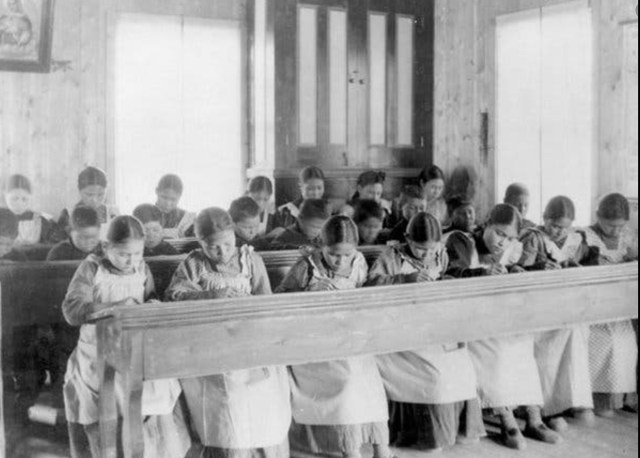Indigenous people all around the globe share a devastatingly sad reality – often, once their lands are “discovered” by others, their lives are forever immeasurably changed, as not only are their lands confiscated, but their very culture is either diminished or destroyed.
The First Nations people are unfortunately no exception. Europeans who first came to North America thought they had arrived in India, and called the people they found here, “Indians.” This terminology is very offensive to the First Nation people so other than writing about a specific treaty or act with that name, I will refrain from using it.
Exploration of Canada by Europeans began with the Norse in the late 10th century on the country’s East Coast and other explorers continued to arrive, including the French and the British, starting in the late 15th Century. The last two countries colonized and fought over land, but by 1763 the French had ceded all its settlements to Great Britain. Also in that year GB enacted the Royal Proclamation that set out the rules by which the colonials and First Nations people would interact with each other for centuries to come. Here are some of its goals:
- Rights and protections for the First Nations people
- Processes by which the colonists could acquire First Nations land
- Assimilate First Nations people into the colonists populations, while still protecting their land
- Create a “definition” of what criteria will be used to define an “Indian”
- Must be of “Indian blood” and be members of a “Body or Tribe of Indians”
- Descendants, non-Indians who intermarried with an Indian or adopted by an Indian
In 1867 the dominion of Canada was created.
A number of Indigenous groups at this time made a series of treaties with the new Canadian government. These treaties detailed how the colonists could secure land for industrial development and settlement. In exchange the First Nations people were promised many things — orally and written — including rights to treaty lands, cash payments, hunting, fishing and farming supplies, and so on.
The very fact that these treaties as well as the Proclamation before “gave” land to the Crown flies in the face of the First Nations core belief that they are only spiritual guardians, not owners of the land. Land cannot be sold or bought. Land is a gift from the Creator and it and all things on it must be treated with respect and in balance with all. Considering this, many believe the First Nations interpreted the treaties to mean that they would share, not give ownership of the land and natural resources to the colonists. This obviously caused tension and confusion – and this was only the tip of abuse iceberg for the First Nations.
In 1876 The Indian Act was introduced as the principal slate of rules through a consolidation of previous colonial ordinances that aimed to eradicate First Nations culture by means of assimilation. To be an “Indian” was to be considered only a transitional state until the First Nations people learned Euro-Canadian habits and language. Also included in the Act and subsequent amendments:
- Forbade First Nations their own governance and culture
- Forbade certain religious ceremonies such as Potlach* and Sun Dancing**
- Forbade First Nations hiring lawyers for land claims without the government’s consent
- First Nations children required to attend industrial or residential schools
The Act was amended a number of times and finally, following World War II, Canada indulged in some serious introspection and began a serious reconsideration to remove some of its most discriminatory sections. Shockingly many of the proposals were not even discussed with the First Nations people themselves until 1951 when a number of the most conspicuously horrible political, cultural and religious restrictions were removed. Potlach was no longer forbidden, land claims could be brought against the government, and women were allowed to vote in band council elections. However, First Nations women still had many severe restrictions. For example, they could lose their status if they married a non-status man. Status rights only flowed through the husband, a woman had none of her own.
Reforms, protests progress and regressions continued until in 1969 a particularly egregious proposal was made by the Trudeau Government called the White Paper. This excerpt from the Canada Encyclopedia explains in more detail:
In 1969, the Trudeau government released its White Paper which declared the government’s intention to entirely eliminate Indian status and the Department of Indian Affairs. Pierre Trudeau was against special status for any group of people, and fully intended to eliminate Indigenous peoples as a distinct group. His idea was to assimilate Indigenous peoples into Canadian society, thereby eliminating any special status and treatment they received up to that point. This included reserve lands, fishing and hunting rights, education rights, medical services, use of land, and economic development on reserve lands. Understandably, the White Paper was met with outrage from First Nations peoples and was immediately countered by the “Red Paper,” created and presented by Harold Cardinal, then-president of the Indian Association of Alberta.
The White Paper was withdrawn.
Today, while there have been many fundamental improvements in the treatment of the First Nations People, as well as some dismantling of Indian Act statutes, it has been a slow and painstaking process and will continue for years to come.
Progress is sometimes at a snail pace, but it is worth the time spent.
#
* Potlach – “ceremony integral to the governing structure, culture and spiritual traditions of various First Nations living on the Northwest Coast and in parts of the interior western subarctic. It primarily functions to redistribute wealth, confer status and rank upon individuals, kin groups and clans, and to establish claims to names, powers and rights to hunting and fishing territories.” From Canadian Encyclopedia
**Sun Dance – “ceremony performed in honour of the sun, during which participants prove bravery by overcoming pain.”




